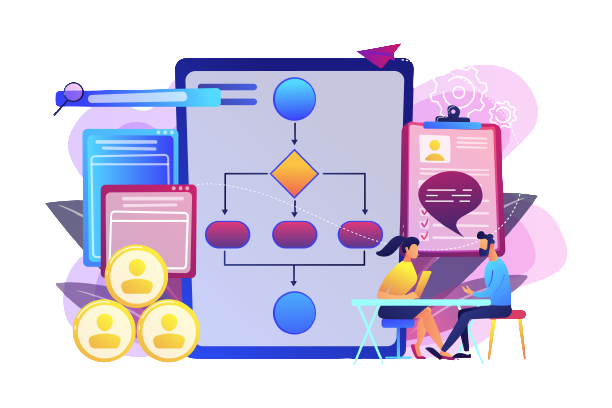
CoinLoan is a financial technology (FinTech) platform that facilitates peer-to-peer lending and borrowing of cryptocurrency assets. It operates on the principles of decentralized finance (DeFi) and leverages blockchain technology to provide users with a secure, transparent, and efficient way to access funds or earn interest on their cryptocurrency holdings by using them as collateral.
Purpose And Objectives
Lending and Borrowing: The primary purpose of CoinLoan is to bridge the gap between cryptocurrency holders who are seeking loans and those who are willing to lend their cryptocurrencies. Borrowers can use their cryptocurrency holdings as collateral to secure loans, while lenders can earn interest on their idle digital assets by funding these loans.
Access to Liquidity: CoinLoan addresses the need for quick access to liquidity without the need to sell one’s cryptocurrency holdings. This is particularly valuable for individuals and businesses that want to retain ownership of their digital assets while still obtaining funds for various purposes, such as investments, emergencies, or opportunities.
Decentralization: CoinLoan embraces the principles of decentralization, allowing users to interact directly with each other through smart contracts on the blockchain. This eliminates the need for intermediaries like traditional banks and financial institutions.
Key Features And Benefits
Collateralized Loans: CoinLoan’s platform offers collateralized loans, meaning borrowers provide cryptocurrency assets as collateral, reducing the risk for lenders in case of default.
Global Accessibility: The platform is accessible to users worldwide, enabling borrowers and lenders from different parts of the globe to participate and transact seamlessly.
Diverse Cryptocurrencies: CoinLoan typically supports a variety of cryptocurrencies, allowing borrowers to use different types of digital assets as collateral and lenders to diversify their lending portfolios.
Automated Smart Contracts: Smart contracts, powered by blockchain technology, automate the lending process. These contracts define the loan terms, interest rates, collateral requirements, and repayment schedules, ensuring transparency and trust between parties.
Flexible Repayment: Borrowers have the flexibility to repay their loans on their own terms within the specified loan duration. This adaptability can be especially advantageous during periods of market volatility.
Interest Earnings: Lenders can earn interest on the cryptocurrency they lend out, contributing to the growth of their digital asset portfolios without the need for active trading.
Transparency and Security: CoinLoan’s blockchain-based system ensures transparency in loan terms, collateral valuation, and interest payments. This reduces the likelihood of disputes and fraud.
Risk Management: The platform implements risk assessment procedures to evaluate the value of collateral and mitigate potential default risks, enhancing the overall security of the lending and borrowing process.
Community and Networking: CoinLoan fosters a community of borrowers and lenders, creating opportunities for networking, knowledge sharing, and potential collaborations.
Financial Inclusion: CoinLoan extends financial services to individuals who might have limited access to traditional banking services, fostering financial inclusion in regions where these services are lacking.

CoinLoan presents a novel approach to lending and borrowing in the cryptocurrency ecosystem, offering participants the benefits of decentralized finance, access to liquidity, and a secure, automated platform for managing collateralized loans.
CoinLoan Mechanism
A. Peer-to-Peer Lending and Borrowing
Explanation of Peer-to-Peer Concept
CoinLoan operates as a peer-to-peer lending and borrowing platform, which means that individuals directly lend their cryptocurrency assets to other individuals seeking loans. This cuts out intermediaries like banks and financial institutions, creating a more efficient and decentralized lending ecosystem. Borrowers and lenders interact through smart contracts on the blockchain, enabling transparent and automated loan management.
Role of Borrowers and Lenders on the Platform
Borrowers: Borrowers are individuals or businesses seeking access to funds without liquidating their cryptocurrency holdings. They offer their digital assets as collateral to secure loans, which are then funded by lenders. Borrowers benefit from quick access to funds while maintaining ownership of their cryptocurrencies.
Lenders: Lenders are individuals who provide their cryptocurrency holdings as loans in return for interest. They can choose loan requests that align with their risk tolerance and desired interest rates. Lenders’ participation in the platform allows them to earn passive income from their digital assets.
B. Collateralized Loans
Importance of Collateral
Collateral is a crucial component of the CoinLoan mechanism. It serves as a security measure for lenders, reducing the risk of default. If a borrower fails to repay the loan according to the agreed terms, the lender can seize and liquidate the collateral to recover the outstanding amount.
Types of Collateral Accepted
CoinLoan typically accepts a range of cryptocurrencies as collateral, including well-established assets like Bitcoin (BTC), Ethereum (ETH), and others. The platform determines the collateral’s value based on market prices and the chosen loan-to-value (LTV) ratio. Different collateral types and their values are used to calculate the maximum loan amount a borrower can receive.
C. Loan Terms and Conditions
Interest Rates
Interest rates on CoinLoan vary based on factors such as market conditions, the specific cryptocurrency being lent, the loan duration, and the borrower’s creditworthiness. Lenders have the autonomy to choose interest rates they find attractive, while borrowers assess these rates when selecting a loan offer.
Loan Duration
CoinLoan offers various loan durations, typically ranging from a few weeks to several months. The borrower and lender mutually agree upon the loan’s terms. Longer loan durations might come with different interest rate structures to account for potential market volatility.
Repayment Options
Borrowers have flexibility in repaying their loans, with options to repay both the principal amount and the interest or to repay only the interest and extend the loan by repaying the principal at a later date. This flexibility accommodates different financial situations and market conditions.
How CoinLoan Works
A. Loan Application Process
Account Creation and Verification
Borrowers and lenders begin by creating accounts on the CoinLoan platform. They are required to complete identity verification (KYC) and anti-money laundering (AML) procedures to ensure compliance with regulatory standards.
Collateral Submission
Borrowers provide information about the cryptocurrency assets they intend to use as collateral. The platform assesses the collateral’s value based on prevailing market prices and assigns a loan-to-value (LTV) ratio that determines the maximum loan amount the borrower can receive.
Loan Request Submission
Borrowers submit loan requests, specifying the desired loan amount, interest rate range, and loan duration. These requests are listed on the platform for potential lenders to review and select.
B. Matching and Funding
Lender Selection of Loan Requests
Lenders review available loan requests and assess the borrowers’ profiles, collateral, interest rates, and loan terms. Lenders can choose to fund whole or fractional portions of loan requests based on their preferences.
Role of Smart Contracts
Once a borrower’s loan request is accepted by a lender, a smart contract is created and executed on the blockchain. The smart contract outlines the terms of the loan, including the collateral, interest rate, loan duration, and repayment options. The collateral is locked in a secure smart contract escrow until the loan is repaid.
C. Collateral Management
Collateral Locking and Release
The borrower’s collateral is locked in the smart contract as security for the loan’s duration. As borrowers make repayments, the smart contract releases a proportional amount of collateral back to them. Once the loan is fully repaid, the remaining collateral is released in full back to the borrower.
Liquidation in Case of Default

If a borrower fails to fulfill the agreed-upon repayment terms (default), the smart contract initiates a liquidation process. The collateral held in the smart contract is automatically sold on the platform to recover the outstanding loan amount and accrued interest. Lenders are repaid first, and any excess collateral is returned to the borrower.
CoinLoan in the Cryptocurrency Ecosystem
A. Comparison with Traditional Lending Platforms
Decentralization: Unlike traditional lending platforms, CoinLoan operates in a decentralized manner, eliminating the need for intermediaries such as banks. This reduces fees, processing times, and the risk of central points of failure.
Collateralization: CoinLoan’s collateralized lending model is distinct from unsecured lending in traditional systems. This provides greater security for lenders and allows borrowers to leverage their cryptocurrency holdings.
Global Accessibility: CoinLoan is accessible to a global user base, providing financial services to individuals who may have limited access to traditional banking systems.
Automation: The use of smart contracts automates many aspects of the lending process, ensuring transparency and reducing the need for manual intervention.
Flexibility: Borrowers on CoinLoan can access funds without selling their cryptocurrencies, maintaining potential upside from price appreciation.
B. Synergies with Decentralized Finance (DeFi) Ecosystem
DeFi Integration: CoinLoan aligns with the principles of decentralized finance by offering permissionless lending and borrowing, automated processes, and direct peer-to-peer interaction.
Interoperability: CoinLoan can integrate with other DeFi protocols, allowing users to maximize their cryptocurrency holdings’ utility across various platforms.
Liquidity Provision: Lenders contribute to the DeFi ecosystem by providing liquidity through their lending activities, enhancing overall market liquidity.
C. Market Trends and Adoption
Growing Demand: The adoption of cryptocurrency and DeFi platforms has driven the demand for lending and borrowing services like CoinLoan.
Evolving Ecosystem: CoinLoan’s success is indicative of the evolving landscape of cryptocurrency finance, where individuals seek alternatives to traditional financial instruments.
Regulatory Landscape: The platform’s adoption may be influenced by the regulatory environment for cryptocurrencies and lending services in various jurisdictions.
Success Stories
A. Real-world Examples of Borrowers and Lenders
Borrower Example: Jane, a cryptocurrency enthusiast, uses CoinLoan to secure a loan backed by her Ethereum holdings. She needs funds for a new investment opportunity without selling her ETH. With CoinLoan, she accesses the required capital while maintaining her exposure to potential ETH price growth.
Lender Example: Alex, a cryptocurrency investor, lends his Bitcoin on CoinLoan to earn interest. By leveraging his Bitcoin assets, he earns a passive income stream while contributing to the lending ecosystem.
B. Positive Outcomes and Lessons Learned
Positive Outcomes: Many borrowers and lenders have benefited from CoinLoan’s services by accessing liquidity, earning interest, and participating in the growing DeFi landscape.
Lessons Learned: Users have learned the importance of understanding loan terms, managing risk, and staying updated on cryptocurrency market trends to make informed lending and borrowing decisions.
Conclusion
CoinLoan’s mechanism revolves around peer-to-peer lending and borrowing, where borrowers secure loans with collateralized cryptocurrency assets. This collateralization enhances security for lenders, who in turn can earn interest on their digital assets. The platform’s transparency, diverse collateral options, and flexible loan terms make it an attractive option for both borrowers and lenders in the cryptocurrency ecosystem.
The CoinLoan platform operates seamlessly due to its use of blockchain technology and smart contracts. The peer-to-peer nature of the process, along with the automation provided by smart contracts, ensures transparency, efficiency, and security throughout the lending and borrowing lifecycle. It’s important for borrowers to manage their repayment commitments to avoid collateral liquidation, while lenders benefit from earning interest on their loans and contributing to the overall liquidity of the platform.
In conclusion, CoinLoan’s presence in the cryptocurrency ecosystem offers an alternative and decentralized approach to lending and borrowing. It aligns with the principles of DeFi, provides opportunities for global users, and reflects the ongoing evolution of how individuals interact with their digital assets. Success stories highlight the platform’s practical benefits and the lessons learned by users navigating this new financial frontier.